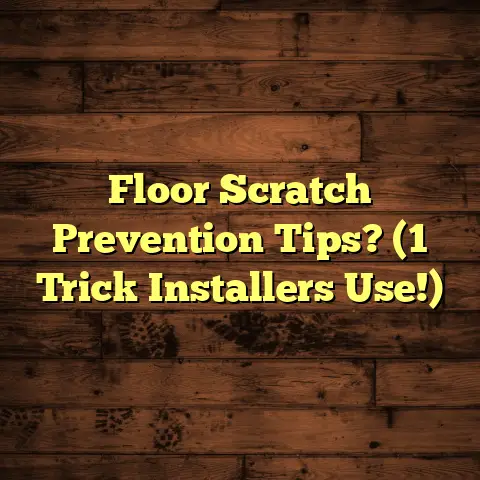Engineered Wood Over Heated Concrete? (1 Mistake!)
Ever tried putting peanut butter on a jelly donut? Sounds kinda crazy, right?
Well, pairing engineered wood with heated concrete can sometimes feel just as… complicated.
Both are great on their own, but together?
That’s where things can get a little tricky.
Let’s dive into the world of flooring and uncover the one mistake that can turn your dream floor into a real headache!
Section 1: Understanding Engineered Wood
So, what exactly is engineered wood?
It’s not your grandpa’s solid hardwood, that’s for sure.
Engineered wood flooring is made up of layers.
Think of it like a plywood sandwich, but with a beautiful hardwood veneer on top.
This construction gives it more stability than solid wood, making it less prone to warping or expanding with changes in humidity.
Why is it so popular?
Well, for starters, it looks fantastic!
You get the real wood look without the real wood price tag.
Plus, it’s versatile.
You can install it in places where solid wood might not be the best choice, like basements or over concrete slabs.
I’ve seen it used everywhere, from cozy living rooms to bustling office spaces.
Where do we use it?
You name it, I’ve probably seen engineered wood there.
Residential homes are a big one, of course.
But I’ve also installed it in commercial buildings, retail stores, and even some light industrial spaces.
Its durability and aesthetic appeal make it a great choice for a wide range of applications.
Section 2: The Characteristics of Heated Concrete
Now, let’s talk about heated concrete.
This isn’t just your average cold, gray slab.
We’re talking about a system that radiates warmth from the floor up, making your home feel incredibly cozy.
How does it work?
Typically, heated concrete systems use radiant heat.
This involves running hot water tubes or electric cables through the concrete slab.
The concrete then acts as a thermal mass, absorbing and radiating heat evenly throughout the room.
Why is it so great?
Heated concrete is super energy-efficient.
It heats the objects and people in the room directly, rather than just heating the air.
This means you can often set your thermostat lower and still feel comfortable.
Plus, no more cold feet in the winter!
It’s a game-changer for comfort.
New build standard?
You bet! More and more new homes are being built with heated concrete systems.
People are realizing the benefits of energy efficiency and luxurious comfort.
Plus, it eliminates the need for bulky radiators or noisy forced-air systems.
It’s a sleek, modern way to heat your home.
Section 3: The Marriage of Engineered Wood and Heated Concrete
Okay, so we’ve got our two main characters: engineered wood and heated concrete.
Can they live happily ever after?
Absolutely! But it takes careful planning and execution.
Can they be friends?
Engineered wood can definitely work with heated concrete.
In fact, it’s a popular choice!
The key is to choose the right type of engineered wood and install it correctly.
Some engineered wood is specifically designed to handle the temperature fluctuations associated with heated floors.
The look is great!
Let’s be honest, the combination looks amazing.
You get the warmth and comfort of heated concrete with the natural beauty of wood flooring.
It creates a luxurious and inviting space that everyone will love.
What’s trending?
I’m seeing a lot of wide-plank engineered wood being installed over heated concrete.
People are also opting for lighter wood tones to create a bright and airy feel.
And of course, herringbone and chevron patterns are always a classic choice that adds a touch of elegance.
Section 4: The One Mistake
Alright, here’s the moment you’ve been waiting for.
What’s the one mistake that can ruin everything?
Failing to properly acclimate the engineered wood before installation.
Yep, it sounds simple, but it’s a killer.
Why is this so important?
Engineered wood, like any wood product, expands and contracts with changes in temperature and humidity.
When you install it over heated concrete, the temperature fluctuations can be even more dramatic.
If you don’t allow the wood to adjust to the environment before installation, it will likely warp, buckle, or even crack after the heat is turned on.
The science behind it
Think about it: wood is hygroscopic.
That means it absorbs and releases moisture from the air.
When the temperature changes, the moisture content in the wood changes, causing it to expand or contract.
Heated concrete can create a significant temperature difference between the top and bottom of the engineered wood flooring.
Horror stories from the field
I’ve seen it happen firsthand.
A homeowner rushed the installation of their beautiful new engineered wood floor over heated concrete.
They didn’t acclimate the wood properly, and within a few weeks, the floor started to buckle and warp.
They ended up having to replace the entire floor, costing them thousands of dollars and a whole lot of frustration.
Another time, I was called in to inspect a commercial building where the engineered wood floor had completely failed.
The installer had ignored the manufacturer’s recommendations for acclimation, and the floor was a disaster.
It was a costly mistake that could have been easily avoided.
Section 5: Consequences of the Mistake
So, what happens if you skip the acclimation process?
Let’s just say, it’s not pretty.
Short-term and long-term effects
In the short term, you might notice gaps forming between the planks, or the floor might start to feel uneven.
Over time, the floor can buckle, warp, or even crack.
This not only looks bad but can also create a safety hazard.
The cost of fixing it
Replacing a failed engineered wood floor is expensive.
You’re looking at the cost of removing the old floor, purchasing new flooring, and paying for installation.
And if the failure has damaged the heating system, that’s an additional expense.
I’ve seen homeowners spend upwards of $10,000 to fix mistakes related to improper acclimation.
Section 6: Expert Opinions and Insights
I’m not the only one who’s seen the damage caused by improper acclimation.
I reached out to some other flooring experts to get their thoughts on the matter.
What the pros say
“Acclimation is absolutely crucial when installing engineered wood over heated concrete,” says Sarah, a flooring contractor with 15 years of experience.
“I always tell my clients to be patient and let the wood adjust to the environment before we even think about starting the installation.”
Another expert, Tom, an interior designer, adds, “I’ve seen so many beautiful floors ruined by improper acclimation. It’s a mistake that no one should make. Always follow the manufacturer’s recommendations and consult with a professional installer.”
Busting the myths
There are a lot of misconceptions about installing engineered wood over heated concrete.
One common myth is that you don’t need to acclimate the wood if it’s already been stored in a climate-controlled environment.
This is simply not true.
Even if the wood has been stored properly, it still needs time to adjust to the specific conditions of the installation site.
Another myth is that you can speed up the acclimation process by turning up the heat.
This is also a bad idea.
Rapid temperature changes can actually damage the wood and make it more prone to warping.
Section 7: Conclusion
So, there you have it.
The relationship between engineered wood and heated concrete can be a beautiful one, but it requires careful planning and attention to detail.
The one mistake that can ruin everything is failing to properly acclimate the engineered wood before installation.
This simple step can save you thousands of dollars and a whole lot of headaches.
Think before you install
Before you embark on your next flooring project, take some time to research the best practices for installing engineered wood over heated concrete.
Talk to a professional installer, read the manufacturer’s recommendations, and be patient with the acclimation process.
Your dream floor will thank you for it!





